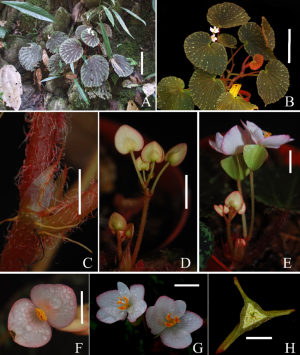Begonia holosericeoides
Begonia holosericeoides
Species Information
Classification and Distribution
Begonia holosericeoides is a newly described species in the Begonia genus, belonging to the Petermannia section. It is endemic to North Moluccas, Indonesia.
Habitat
This begonia species thrives in shady environments on vertical moist rock surfaces, including limestone substrates. It is typically found in primary lowland forests at an altitude of approximately 145 meters.
Distribution
Begonia holosericeoides is exclusively found in the Aketajawe-Lolobata National Park on Halmahera Island in the North Moluccas, Indonesia.
Characteristics
- It is a perennial, monoecious herb with creeping stems, reaching a length of around 15 cm. - The stems are few-branched, with internodes approximately 10–12 mm long, and they are densely covered with branched hairs. - Leaves are alternate, with persistent stipules and red petioles. - Leaf lamina is asymmetric and ovate, with a cordate base and acuminate apex. - The adaxial surface of the leaves is glabrous and dark green reddish, often variegated with silver bands or spots between the veins.
Flower Details
- Male flowers have two white tepals, which are broadly ovate, measuring 13–15 × 11–13 mm. - Stamens have yellow filaments and oblong anthers. - Female flowers have five tepals, with the four larger ones being broadly ovate and adaxially concave, measuring 10–14 × 10–12 mm. - The ovary is ellipsoid, densely hairy, with three locules and axile placentation.
Etymology
The specific epithet "holosericeoides" is derived from "holosericea" (the species epithet of Begonia holosericea) and the Greek suffix "-oides," indicating resemblance. It refers to the creeping habit and adaxial leaf pattern, which resemble those of B. holosericea.
Comparison to Similar Species
Begonia holosericeoides is similar in appearance to Begonia holosericea but can be differentiated by several characteristics, including leaf shape (ovate with an acuminate apex in B. holosericeoides, versus suborbicular with a rounded apex in B. holosericea), sparsely hairy or glabrous ovaries (versus densely hairy ovaries in B. holosericea), and the length of female inflorescence peduncles (1.1–3.5 cm in B. holosericeoides, versus 2–3 mm in B. holosericea).
References
- [Include the citations for the research papers that provided this information]
Care
Information about the cultivation and care of Begonia holosericeoides is not provided in the research papers.
Photos
External Links
No external links related to Begonia holosericeoides are available at this time.
